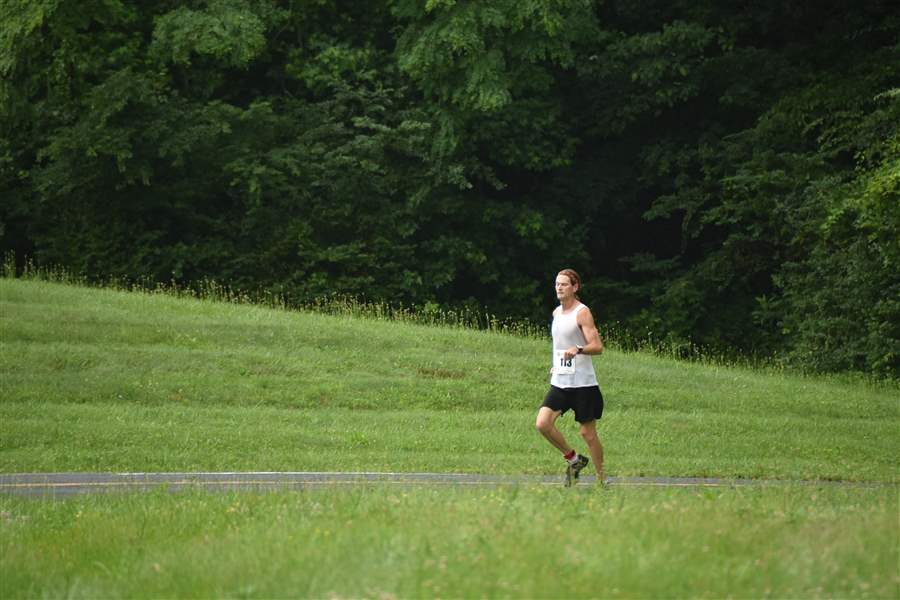
Findlay instructor off and running with novel
4/22/2018
Dave Essinger says running is a physical and emotional outlet for him and sparks ideas for his writing. He will sign copies of his book Friday at Art & Soul in Toledo.
It was 13 years ago, maybe 14, that Dave Essinger and his wife, Alice, decided to be adventurous and run Toledo’s Glass City Marathon.
“It was painful, so we thought we’d do another,” said Essinger, who lives in Bluffton, Ohio, teaches a little bit of everything, including English, creative writing, and fiction, at the University of Findlay.

Dave Essinger says running is a physical and emotional outlet for him and sparks ideas for his writing. He will sign copies of his book Friday at Art & Soul in Toledo.
And he’s not kidding. He has finished more than a dozen marathons and several ultramarathons, including races that have been 100 miles.
Sunday morning, he will be at the University of Toledo for the Mercy Health Glass City Marathon.
Running became, and continues to be, a physical and emotional outlet for Essinger, who aims for 35-40 miles of running a week. “My daily run or workout is necessary to clear the head.”
Some of those runs spark ideas for his writing. Essinger, whose fiction and poetry has appeared in several literary magazines, is the author of Running Out, a novel about long-distance running.
“There is an awful lot of writing about running, about ultrarunning, but most of that is nonfiction,” Essinger said. “There are some well-known novels about running, including [John L.] Parker’s Once a Runner. I didn’t feel that it had been done well as far as long-distance running and getting the sport right.”
In Running Out, elite endurance runner Dan Collins, his wife, Deb, and their daughter are stranded in the Canadian wilderness after a plane crash. With his wife unable to walk because of a broken leg, Collins sets off for help, relying on his endurance training. The trip forces Collins to reflect on his life, his running obsession, and to analyze the changes his body is undergoing as he churns up the miles under harsh conditions.
Long-distance running is a physiological puzzle. Runners need to train their bodies to maximize oxygen intake and to use glycogen reserves more efficiently. Essinger expertly discusses the physical processes throughout Collins’ journey.
“Some of us runners are really into what happens in our bodies. I’m kind of a nerd and like researching,” Essinger said. “I have no hard science background, but I did a lot of research for this book.”
Essinger put a nearly equal amount of thought into his plot, particularly the use of the James Bay region of Canada as the crash site. James Bay Road in northwestern Quebec stretches 385 miles between Matagami and Radisson, with no cities or villages in between.
“I thought about using the Michigan Upper Peninsula, but James Bay is so empty. It’s the farthest you can get by road from human settlement than anyplace on earth. I went up there and said, ‘This is the place,’” Essinger said. “I love plot. Sometimes plot is almost a dirty word for some writers. I want to put my characters in difficult situations, make it hard, and see what they do.”
Essinger will be at Art & Soul, in Toledo’s Cricket West shopping center, to do a reading from Running Out from 6 p.m. to 7:30 p.m. Friday. His book is available on Amazon, and additional locations can be found on his website, dave-essinger.com. He is in the process of recording an audio version of his first published novel.
“That’s been a real learning experience. I thought I would sit down and read into a cheap microphone, hit record, upload, and be done, but no. It’s very time-consuming. It’s not that easy,” he said.
Few things are easy for Essinger’s. But he and most endurance athletes embrace difficult challenges, including pushing their bodies to seemingly impossible extents in marathons and ultramarathons
“There comes a point where you want to stop — your body wants to stop, your mind wants to stop. But if you had to go a few more steps, you could go a little farther,” Essinger said. “There is a reason why people are doing these events. There are not many opportunities in our society to go farther than you think you can or figure out what your body actually can do.”
Contact Brian Dugger at bdugger@theblade.com or on Twitter @DuggerBlade.